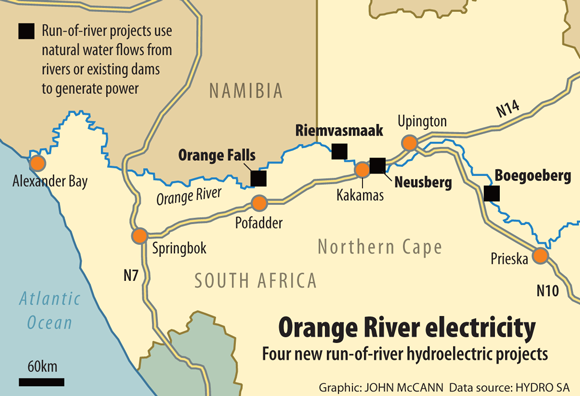Plans to build a series of hydroelectric plants along the Orange River – including one at the Augrabies Falls – have provoked a storm of protest among local communities and environmentalists.
South African National Parks (SANParks) has voiced its opposition to elements of the project, suggesting that the proposed R1-billion Augrabies scheme would disrupt the local ecology and have a detrimental impact on tourism.
The 60m falls, the world’s fifth highest, are among South Africa’s most spectacular natural features.
Also targeted for hydroelectric schemes are the Orange Falls (also known as the Ritchie Falls) near the towns of Pofadder and Onseepkans, as well as the Neusberg plant near Kakamas, which is already under construction, and the Boegoeberg Dam in Groblershoop.

Environmentalists have objected, claiming that the cumulative impact of the projects poses a threat to the Orange River and the 11% of the lower river environment that remains pristine.
Environmental impact assessments (EIAs) are yet to be done for the Augrabies and Orange Falls schemes.
Resistance from locals
The planned plants, to be built by private South African company Hydro SA in partnership with state-owned Australian firm Hydro Tasmania, have hit resistance from local residents, some of whom depend on ecotourism for survival.
Various sources at Onseepkans told amaBhungane that angry residents and the mayor of Khai-Ma Local Municipality, Aurelia Josop, prevented consultancy Aurecon from finishing its presentation at a public participation meeting last month.
Khai-Ma’s communications officer, Alfriedo Green, confirmed that the municipality did not support the development. He cited the lack of benefits for Onseepkans residents, the damage that would be caused to an unspoiled environment and the municipality’s contested border between Namibia and South Africa as the main objections.
In Pofadder, residents allegedly told the presentation team “that they must go away. Nobody wants the falls damaged.”
Orange Falls Hydro Electric Power, Hydro SA’s specially created subsidiary for the Orange Falls project, plans to construct a run-of-river hydropower station with a capacity of 30 megawatts about 11km from Onseepkans.
It would use flow-focusing structures and two low weirs to direct water to the hydropower plant, diverting water away from the falls and releasing it in the lower southern channel of the Orange River, 250m downstream.
At Augrabies, subsidiary RVM1 Hydro Electric Power plans to construct a 40MW hydropower station north of the falls. Water would be extracted about 1.5km upstream and be returned to a branch of the river 7.5km downstream.
The powerhouse and tailrace would be located on land belonging to the Riemvasmaak Community Trust in the Augrabies Park, and a 2.5m-long weir across the Orange River and 4.6km-long underground culvert would be located on SANParks land.
Organisations fighting the project
Among the organisations fighting the Orange Falls project is the African Paddling Association. Emphasising the falls’ unspoilt ecology, Marie-Louise Kellett, from the association’s environmental working group, said they are not accessible by road, only by foot or raft. Kellett also runs a rafting company, Gravity Adventures, on the river.
SANParks’s Gabrielle Venter particularly objects to the elements of the project in the Augrabies Park.
A SANParks report sent to Aurecon and the water affairs department points out that the planned culvert would pass through the area of the park “which provides the highest form of protection”.
“The zone also serves to protect sensitive environments from development impacts and tourism pressure. The conservation objective is to maintain the zone in as near to a natural state as possible with no impact on biodiversity patterns or processes,” the report says.
Venter also complained about the visual impact the hydroelectric scheme is likely to have, both on the park and in terms of the reduced water flow over the falls. She said that the diverted water would undermine the integrity of the ecosystem.
'Pristine wilderness … will be irrevocably damaged'
Kellett expressed concern about the cumulative effect of the hydroelectric plants. “The whole river needs to be considered as a system,” she said. “This pristine wilderness and associated sense of place will be irrevocably damaged.”
She said a report of the Orange-Senqu River Commission, an international body representing the four countries of the Orange River Basin, pointed to the potential danger to threatened fish species in the lower river.
Kellett cited the management plan for the lower Orange River, commissioned by the water affairs department in 2008, which says that the Orange Falls and the Orange Gorge have been recommended for formal environmental protection.
Commenting on the potential knock-on effect on ecotourism –particularly rafting operations – in the area, Luise Niemoller Coertzen of Pofadder Tourism said: “Tourism development is the only hope for long-term job creation in our remote areas and will be seriously affected in a negative way.
“The fact that the falls can only be reached by hiking or canoeing makes it a very sought-after destination for local, international and celebrity visitors,” Coertzen said.
The Peace Parks Foundation, one of the registered interested parties, argued that the projects had potential implications in downstream areas such as at the Richtersveld Transfrontier Park.
Schemes to be 'consistent with environmental values'
In response, Hydro SA director Niel Theron said that all water used in the Orange Falls project would be returned to the Orange River and that at Augrabies “the amount of water [extracted] is very little in terms of the flow regime”.
Theron added that at Augrabies the powerhouse, piping and power lines would be underground and that the structure in the river would be barely visible.
“We have dedicated much effort to ensuring that … both proposed schemes are consistent with the environmental values of each site, including visual amenity and sense of place,” he said.
The EIAs will be “focused on identifying options for each scheme that are sympathetic to the environment and its surrounds and minimise the impact … on the environment.
“This is a sensitive project; we’re very aware of that. A lot of people misunderstand exactly what we do. These projects don’t exist elsewhere in South Africa,” Theron said.
“We have put a pause on the process so that we may engage more with the public to ensure that they get the message and understand it, and are then able to comment on an informed basis,” he added.
Mixed messages?
Asked about the potential benefits to local residents, Theron said: “The [Neusberg] project is currently in construction and is providing job opportunities for members of the surrounding communities. We have arranged for the surrounding communities to take 15% ownership in the project through a community trust funded by the IDC [Industrial Development Corporation]. When the project … starts to yield income from the power it generates and sells to Eskom, the community trust will receive funds.”
Neusberg is the first run-of-river small hydro scheme to be delivered under South Africa’s renewable energy independent power producer procurement programme and will deliver 10MW of base-load power to the local energy market.
Hydro Tasmania spokesperson Samantha Meyer said that the EIAs “and any associated approvals for these projects will be conducted in accordance with the laws of South Africa and Namibia, as is appropriate for each project”.
Although parts of the Orange Falls project would be built on the South African side of the river, Hydro SA regards this as a Namibian project and hopes to sell power generated to that country’s power utility, Nampower.
Theron told amaBhungane that his company is “in ongoing talks” with Nampower. But Nampower’s chief executive, Paulinus Shilamba, said the utility has neither made a commitment to Hydro SA nor entered into negotiations with it.
Shilamba added that Hydro SA had approached Nampower a year ago, but the company could not provide the information required to start power purchasing negotiations.
He recalled that two follow-up meetings, at a technical level, had since taken place but that nothing had been decided.
The South African departments of water affairs and energy had not responded to amaBhungane’s questions at the time of going to print.
* Got a tip-off for us about this story? Email [email protected]

The M&G Centre for Investigative Journalism (amaBhungane) produced this story. All views are ours. See www.amabhungane.co.za for our stories, activities and funding sources.